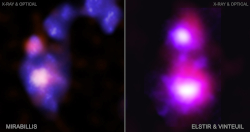HEAPOW: Building Bigger Black Holes (2023 Mar 13)
Posted: Mon Mar 13, 2023 3:50 pm
 Building Bigger Black Holes
Building Bigger Black Holes
The origin of supermassive black holes is one of the more pressing issues in modern astrophysics. These monster black holes, weighing in at millions or billions of times the mass of the sun, are found near the centers of almost every galaxy. But where did they come from? We know that galaxy mergers are quite common in the Universe (and probably more common in the early Universe), so it's reasonable to suspect that these supermassive black holes are formed by mergers of lower-mass black holes which can occur when small galaxies collide. Seeing this process in action though is a bit difficult. Now a new study has found the best evidence so far for impending mergers of small, "dwarf" galaxies (small galaxies less than one twentieth the mass of our own Milky Way) containing black holes. These dwarf-dwarf galaxy mergers are among most interesting type of mergers since dwarf galaxies are believed to be the most common type of galaxy in the early Universe. Scientists conducted a painstaking search of deep X-ray images in the archive of Chandra X-ray Observatory observations to reveal faint accreting black holes, and cross-matched these sources with small galaxies seen in infrared images obtained by NASA's Wide Infrared Survey Explorer (WISE) to reveal dwarf galaxies containing X-ray emitting, accreting black holes. Dwarf merger candidates were then identified by looking for pairs of dwarf galaxies close together in the sky which showed evidence of interaction, like extended tails of material or bridges of gas as a tell-tail sign of gravitational interaction. The images above shows the first two pairs of merging dwarf galaxies found so far. The left image shows two dwarf galaxies with an extended tail of matter pulled from the galaxies trailing behind them. This pair was dubbed "Mirabilis" by astronomers after the Marvelous Spatuletail (Loddigesia mirabilis), an endangered species of hummingbird known for their exceptionally long tails. The image on the right shows a pair of interacting dwarf galaxies with a bridge of material extending from one to the other. These galaxies were dubbed Elstir and Vinteuil, after characters from Proust's "Rembrance of Things Past". The X-ray emission, shown in pink in both images, shows the likely location of accreting black holes in each of the dwarf galaxies. Sometime in the future, these pairs should merge together into larger galaxies with bigger black holes, shining even brighter in X-rays, and producing gravitational waves, perhaps detectable by a far-flung descendent of LISA.
CXC: Giant Black Holes on Collision Course
viewtopic.php?t=42960
| << Previous HEAPOW | High Energy Astrophysics Picture of the Week | Next HEAPOW >> |